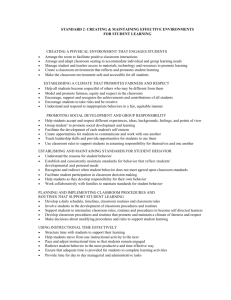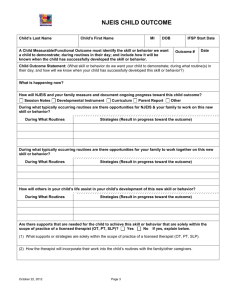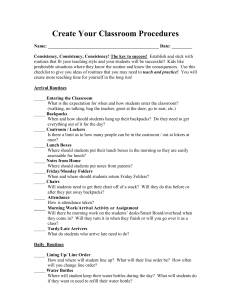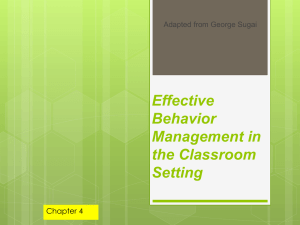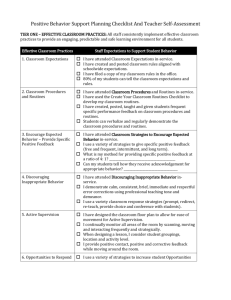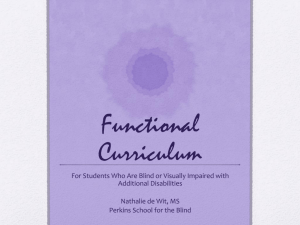YolandaWrightDevelopweek5
advertisement
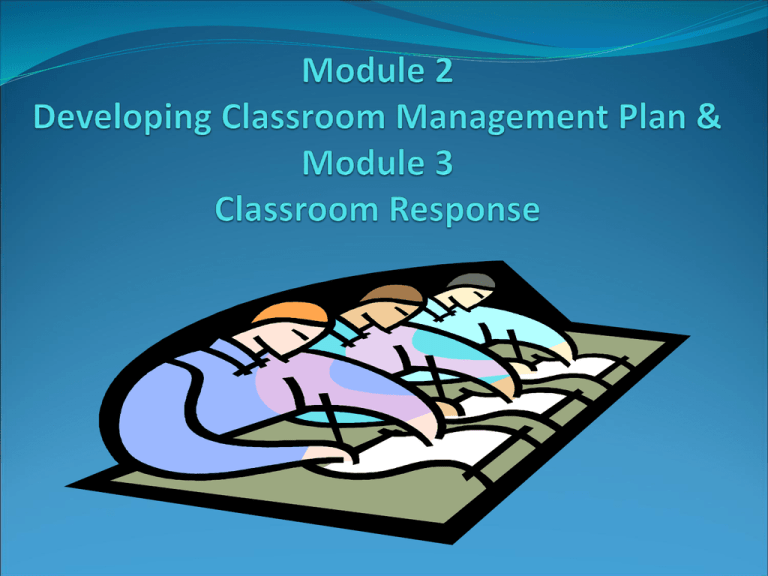
Objectives: Upon completion of this module learners will be able to: Understand how to establish and maintain consistent routines and procedures in order to set the tone for the classroom create a safe learning environment Topics: Best practices for classroom management Ineffective classroom management Effective objectives for students to follow Best Practices for Classroom Management Classroom management is the process of making rules, holding students accountable for their actions, providing consequences for negative behaviors and rewarding positive behaviors Maintaining order within the classroom is essential for teachers and students to interact within a healthy learning environment. The following are best practices for teachers to follow in order to effectively maintain order within the classroom. Establish guidelines for students to follow daily. Classroom rules helps teachers and students to stay organized. Best Practices for Classroom Management Getting students involved with the development of the guidelines will help to gain their buy in to the agreement. Creating a Behavior Contract will help students to understand why guidelines are some important and by soliciting their assistance, helps them to take ownership of their actions. Class Behavior Contract Exercise Pair up into groups of three, one person will be the teacher and the other two will act as students. Ask the students the following questions and document their answers on flip chart paper. Once complete, the class will review the responses and place a check mark beside an idea as it is repeated by other groups. Discuss the differences and similarity of the responses. Question 1: How do you want me to treat you? Question 2: How do you want to treat one another? Question 3: How do you think I want to be treated? Question 4: How should we treat one another when there is conflict? Retrieved fromhttp://www.educationworld.com/a_lesson/lesson/lesson274.shtml Encourage the students to sign the classroom agreement after it is completed. Best Practices for Classroom Management Classroom management starts with the teacher. When determining the best course of actions, teachers should conduct an analysis on his or her current classes and answer the following questions: What method do you employ to get your students attention? (Count to three? Raise your hand? Flick the lights or a bell?) What are your students expected to do when they come in first thing in the morning? from recess? lunch? What routines are in place when students finish work early? How do your students ask for assistance? What are the consequences for unfinished work? late work? sloppy work? the student who refuses to work? Best Practices for Classroom Management What are the consequences when a student disturbs another student? Where do students turn their assignments/tasks in? What are your routines for sharpening pencils? How does a student ask to leave the room to use the washroom? Can more than one go at a time? What are your dismissal routines? What are your tidy up routines? How are your students aware of all of your routines? Retrieved from http://specialed.about.com/cs/teacherstrategies/a/routines.htm The questions will help teachers to develop routines for the students to follow; however, one must remember that if breaking the rules are not followed by consequences it defeats the purpose. Best Practices for Classroom Management Students should also have consequences for following the rules as well. Rewarding good behavior provides an incentive for others to follow. Building relationships is an important aspect of managing student behaviors. Teachers should take a proactive step in getting to know each student in order to understand his or her motivational and de-motivational attributes. Teachers cannot fix what they cannot understand. Taking the time to get to know the students builds trust, respect and it allows the student to open up to the teacher more easily when something is wrong. Best Practices for Classroom Management Classroom management is determined by time management. If there are gaps of time when instruction or activities aren’t taking please leaves room for disruptions to commence. Therefore, teachers should create detailed lesson plans, prepare more material than the allotted time. And keep the students engaged every moment they are within the classroom setting. Finally, the physical setting of the classroom plays an important part of maintaining behaviors. The physical setting of the classroom should be arranged in a manner that is conducive to learning. Best Practices for Classroom Management Learning begins from the moment the students enter the classroom and teachers should maximize every teachable moment. The learning environment is a key component within that process. One way to ensure the physical setting is conducive to learning is to utilize the physical setting checklist retrieved from www.pbismaryland.org . Teachers can also use the checklists on each other in order to critique the physical settings of their classrooms respectively. Physical Setting Checklist The physical classroom setting is organized in a manner that promotes learning and independence, as evidence by: Observation Yes 1. Are the walls, floors, and furniture clean and in good repair? 2. Is the furniture adjusted to the proper size for the students? 3. Are rules, routines, and procedures posted in a manner that is easy to see? 4. Are rules, routines, and procedures posted in a manner that all could read or understand (visuals)? 5. Are unnecessary and distracting items removed from view and reach? 6. Are all materials organized and easily accessible? 7. Do students have secure and adequate spaces for personal storage? 8. Has furniture been placed to decrease traffic flow challenges? 9. Do instructional areas of the classroom have clear, visual boundaries for students? No Retrieved from http://www.pbismaryland.org/documents/Best%20Practices%20Checklist.pdf Unclear Ineffective Classroom Management Ineffective classroom management results from but not limited to the following: Using physical contact to correct negative behavior Verbalizing strong demands for students to perform in an authoritarian manner. Motivating with an iron fist. Loosing one’s temper in reaction to a student’s negative behavior. Reacting out of anger Using sarcasm towards students in a form of mocking remarks usually intended to wound as well as amuse. Ineffective Classroom Management Constantly warning a student of the consequences of his or her bad behavior but never following through with the actual discipline. Note: The afore mentioned attributes are counter productive to a positive learning environment. Ineffective Classroom Management Video The link below depicts a classroom setting in which classroom management is ineffective. While watching the video, learners should document any observable ineffective classroom management practices demonstrated by the teacher and students. Prepare to discuss the findings after the video is shown. http://www.youtube.com/watch?v=B4b8GQ-2YfU Effective Objectives for Students to Follow It is important for teachers to devise effective objectives for students to follow. The objectives should be created to promote desired behaviors and results. Having a plan is essential to accomplishment of any objective. Students will know if a lesson or activity is facilitated to them lacking the preparation necessary for a successful outcome. Therefore, it is important to plan, plan, plan. The objectives should promote classroom participation. Students should be encouraged to respond clearly and politely during classroom discussion. Effective Objectives for Students to Follow Teachers should set the example by displaying a positive attitude, an eagerness to set a positive tone and the ability to promote a positive culture within the classroom. Teachers should strive to understand the students’ points of views by putting themselves in the students’ shoes and seeing things from their perspective. By doing so, the teacher will develop the level of empathy needed to identify with the students on their level. Remember students are people to. Module 3 Classroom Response Objective Upon completion of this module, learners will be able to respond appropriately to students’ behaviors within the classroom. Topics Conflict Resolution Physical Proximity Conflict Resolution Conflict resolution is the act of facilitating a peaceful ending to a dispute of disagreement. Students with social behavioral problems often shout out answers, grab or snatch items from others and possibly become physically violent with other students. In order to combat social behavioral problems demonstrated by students or to minimize conflict, teachers must understand how to employ the three levels of conflict resolution. The three levels of conflict resolution are negotiation, mediation and arbitration. Negotiation- When two or more parties meet to resolve their issues or concerns with each. Conflict Resolution Mediation – Utilizing a third party to resolve the issues among two or more people. Arbitration – Utilizing a neutral party to assist with the resolution of a dispute among two or more people. Communication is key to conflict resolution. Teachers must be able to identify and decode verbal and nonverbal queues communicated among students to indicate if conflict is on the horizon. Students may communicate with each other in the form of an argument or strife. Conflict Resolution They may communicate the existence of conflict in a non-verbal manner by making an angry face, folding their arms in a rebellious manner, they may demonstrate gestures that are currently known to offend and hurt others. Teachers must remain alert and constantly scan the classroom to give a long glare to discourage inappropriate behavior and to serve as acknowledgement of all activities the students are currently engaged in. Physical Proximity The physical proximity of student within the classroom can play an important part in maintaining order within the classroom. Student have friends within the class which causes them to become chatty or loose focus. Others may have classmates they cannot get along with that causes disorder. Students may become distracted if they sit next to a window in which they move their attention to what's going on outside of the classroom instead on focusing on the teacher. Some students loose focus if they sit in the back of the class, they become disinterested and feel as though they can get lost within the classroom. Physical Proximity Teachers have to take a proactive step in understanding the overall make up of their classroom and understand the characteristics of their students. If teachers have students who negatively impact the hormonal balance of the classroom, may have to reassign seats whenever necessary and move students, who become distracted by outside elements that are easily viewed from within the classroom. Classroom Management Jeopardy Lets find out how much we have learned from classroom management courses. Divide into two groups, prepare to provide your answers in the form of a question. If the answer is not in the form of a question, the team will loose its turn. Classroommanagementjeopardygame.ppt Conclusion In order for classroom management to occur, teachers must understand the importance of providing sound structure within the classroom. Ineffective classroom management is detrimental to the learning process. Teachers cannot effectively facilitate the lesson and students cannot retain the information communicated by the teacher. Effective classroom management requires teachers to engage in effect lesson planning by adding more material than needed. This concept allows for instruction to monopolize the entire time set aside for instruction. Classroom agreements are most beneficial when teachers reach out to students to seek their buy in to the process. Conclusion Cont. Teachers must take appropriate steps to build relationships with their students in order to understand what motivates and demotivates them. Creating checklists and seeking the observational assistance of peers helps teachers ensure that all aspects pertaining to classroom management is taken into consideration. Finally, teachers must understand that learning occurs at the very moment students enter the classroom. Teachers must project a positive attitude and lead by example and ensure that there are consequences for behaviors demonstrated by the students. Positive consequences for positive behaviors and negative consequences for negative behaviors. Students must understand the big picture and how they fit into that process and that the overall goal of classroom management is to create a positive environment conducive to learning. References Ten activities for establishing classroom rules/lesson plan. (2011, July). Retrieved January 3, 2012 from http://www.educationworld.com/a_lesson/lesson/lesson274.shtml Classroom routines: a must! Supporting behaviors with routines. (n.d.) Retrieved January 3, 2012 from http://specialed.about.com/cs/teacherstrategies/a/routines.htm Classroom management ms. gray’s class. [YouTube video]. (2009 March, 19). [with Shannon Mahoney, Leah Gray, Roger Freed, Milton MacDonald, Jason Pearson, Cathleen Soltis and Chris Dubbs]. Retrieved from http://www.youtube.com/watch?v=B4b8GQ-2YfU Best practice classroom management checklist. (n.d.) Retrieved January 3, 2012 from http://www.pbismaryland.org/documents/Best%20Practices%20Checkli st.pdf

